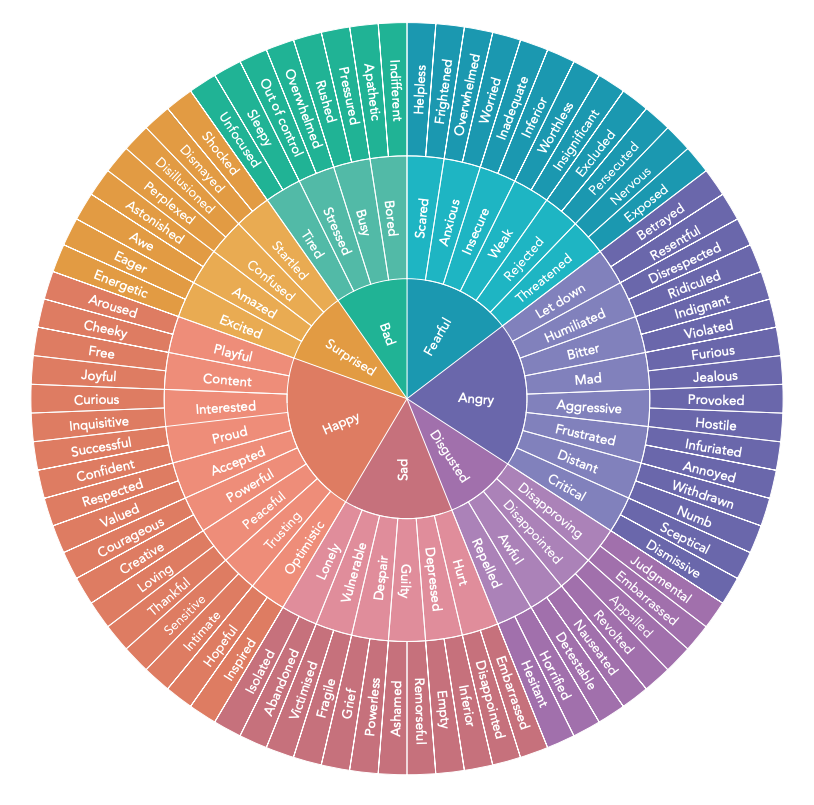The Feelings Wheel
A Path to Emotional Freedom and Inner Peace
Emotions are powerful. They shape the way we see the world, relate to others, and speak to ourselves. Yet most of us were never taught how to truly understand what we feel.
The Feelings Wheel is more than just a colorful chart. It is a map for the heart, guiding us from confusion to clarity, from numbness to awareness, and from pain to peace.
Use it as a daily mindfulness practice to deepen self-awareness, cultivate emotional freedom, and reconnect with your inner truth.

What Is the Feelings Wheel?
The Feelings Wheel organizes emotions visually. Core emotions at the center include:
- Happy
- Sad
- Angry
- Fearful
- Disgusted
- Surprised
From there, secondary and tertiary emotions expand outward, helping you move from general to specific emotional awareness.
Why Most People Struggle to Name Their Emotions
- You were taught to hide emotions (e.g., "Stop crying", "Be strong").
- You were never given the words for emotions, limiting emotional understanding.
- Emotions can feel overwhelming, especially when multiple arise at once.
The Feelings Wheel gently uncovers the truth beneath the surface, guiding you toward awareness and clarity.
The Feelings Wheel as a Meditation Tool
It invites you to slow down, breathe, and observe your emotions without judgment. Combined with meditation or breathwork, it becomes a powerful pathway to inner peace.
Why Naming Emotions Heals the Heart
Labeling emotions calms the brain, reduces stress, and opens the door to self-compassion. You turn pain into information, and information is power.
How the Feelings Wheel Builds Emotional Intelligence
- Self-awareness: Learn what you truly feel in the moment.
- Self-regulation: Choose healthy responses to your emotions.
- Empathy: Recognize emotions in others.
- Communication: Express your truth clearly and respectfully.
Simple Daily Practice
- Pause and take three slow breaths.
- Ask yourself, “What am I feeling right now?” Choose a core emotion.
- Move outward on the wheel to explore secondary and tertiary emotions.
- Speak or write what you feel, e.g., “I feel overwhelmed because …”.
- Identify what you need to release or receive for emotional balance.
Real-Life Examples
- Work stress: Fearful → Insecure → Doubtful.
- Relationship conflict: Angry → Hurt → Rejected.
- Joyful moments: Happy → Proud → Accomplished.
Spiritual Growth
Embrace every emotion. Fear shows where to create safety, anger shows boundaries, sadness shows what needs release, joy shows where the soul comes alive. Honor emotions to honor your truth.
Journaling with the Feelings Wheel
- What emotion am I feeling?
- Where do I feel it in my body?
- What triggered it?
- What is it trying to tell me?
- What do I need to release?
- What can I learn from this?
Using the Feelings Wheel with Others
Couples, parents, teams, or friends can use it to deepen emotional awareness and improve connection. Emotions are invitations to listen, heal, and grow.
Your Journey Starts Now
Try the Feelings Wheel once a day. Let it guide you inward, help you breathe through discomfort, and celebrate small joys. Over time, you will notice patterns, trust yourself more, and feel lighter.
